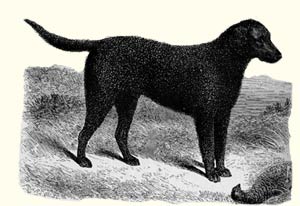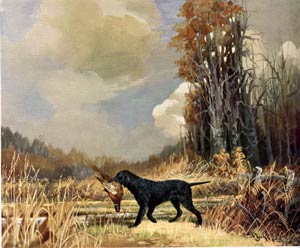
| The Curly Coated Retriever |
|
|
| The Curly Coated
Retriever was once probably the most popular working retriever and
was a well established breed by the early 1800s. Stonhenge ( 1879)
in the third edition of his 1859 book "The Dog in Health
and Disease" refers to only two types of retrievers the
Curly Coat and the Flat or Wavy Coated retriever. From the illustration
reproduced here it can be seen that the curly coat type was well
established at that time. Most dog books of that era give a few
paragraphs on the curly coat but the definitive history of the breed
must surely have been written by John
Lennon in his book,
"The First Curly Coated Retriever Book of Champions 1860 - 1997" He has pulled together an impressive and comprehensive
array of material including an excellent piece with which he illustrates
how "form fits function." It had been cold for several days and was still freezing, but it was too rough for the ice to settle down on that water. In the dark I couldn't tell whether it was water or ice; I only knew that the keepers reported a good many fowl about in the morning, so I went down to see what I could get. They came over now and then and I got seven or eight down. Some fell on the water and some on the land. It gradually got light, and then I saw that the water was covered with ice, but it could not be thick because on the previous day there had been none, and it was now unduly thickened through the water's previous readiness to freeze. Prince Rupert was a little out of condition, but he knew my signals and when the time came to retrieve these birds, there was a teal lying on the ice about fifty yards out. I pointed it out to Prince, and he went for it. He dashed through the sedges and made his way to the bird. The ice was not thin enough for him to swim through; he had to fight his way through it with his forelegs. When within about a yard of it he was exhausted, but, craning his neck over the ice, he kept making futile attempts to get the bird. He would not turn back. But presently lay perfectly still on top of the water. My two keepers were coming up to join me. and they arrived at that moment. Of course it meant drowning. I asked the men if they could suggest anything,
and there was no rope, no boat, no anything. The water was deep.
I was frantic. The poor dog was out there with not much of a kick
left in him, yet even then he tried to crane his neck to get the
bird. When we got within a yard or two of the bank, the whole contraption gave way, but of course I could struggle out. The dog was apparently dead. Coated with ice, he was an ice dog - ice all over him in a great big mass. We had to kick it off him. We carried him down to the decoy house, laid him in front of the fire, gave him brandy, kept rubbing him of course - and he lived for years after." EXTRACT FROM "DR. SALTER, HIS DIARY
& REMINISCENSES FROM THE YEAR 1848 TO 1932" |
|
Curly Coated Retriever by R Ward Binks |
|
Patrick Chalmers charming
poem published in 1931 emphasises the wildfowling function of
the dog.
WATERPROOF (THE CURLY-COATED RETRIEVER) His brow is so spacious He looks so sagacious, The very owdacious Old workman is he, And out late and early, A black dog and burly, And coated as curly As corkscrews can be; When scent is all tricky, When cover is thick, he Can pick any dicky- Bird, titled as game, That you. Sir, can slaughter; But it's in cold water {His wig twisting tauter) That most he wins fame; Since to curls unmonastic But closely elastic No weather's too drastic, His clusters are none That rainstorms can raggle Or haggle or draggle, Agog for the gaggle, He sits by the Gun; And let tides as they will race Away like a mill-race, Shall your game, in their chill race, Go out on the floods'? Nay, a dog, black and curly, With curls that are twirly, Bobs back through the hurly- Green water, white suds; With a goose that is big and A shake of his wig [and The diamond drops jig and "Jump off him like rain, The pearly drops glisten) He's landed, "Here's this 'un," Says he, "Now, let's listen For gaggles again." Down he sits, oh, let none err, The dog that's the one-er To wait, with the gunner, The jowl off the sea- A black dog, a burly, Whose black coat is pearly With raindrops and curly As corkscrews can be! From Gundogs
by Patrick Chalmers(1931) |
|
In his book Lennon
traces the roots of the breed and with his kind permission we
have published an extract below:
"The Curly Coated Retriever Their ancestry is unknown but it is widely believed that they are the product of crosses between the now extinct English Water Dog, the Large Rough Water Dog, the Small Water Spaniel, the Large Water Spaniel, the Tweed Water Spaniel, the St. John's or Lesser Newfoundland Dog, the Llandidloes Welsh Setter, the Irish Water Spaniel, and the Poodle. Quite a mixture you will agree, but even so, colour, type, and conformation had been fixed as long ago as the mid-1800s making the Curly one of the oldest, if not the oldest retrieving breed of gundog still being shown and worked today. Although various breeds seem to be involved in the evolution of the Curly Coated Retriever the end result is a large gundog, 27 inches at the withers (compared with the modern Labrador Retriever at 22 inches); they are black or liver in colour with a waterproof coat, hence its great stamina and proven ability to stand up to a long wet day in the field, or frequent immersion in water when out wildfowling. When working in water the dense curls of the coat are virtually water-tight so cold conditions hold no fear for him. The wildfowler often prefers the liver variety as they tend to blend in with the background found in marshes, shores or lakesides. His coat also offers good protection when hunting in potentially hazardous undergrowth Years ago, before the Labrador assumed the key position amongst Gundog Retrievers, the Curly was probably the most popular shooting dog and was especially appreciated by gamekeepers, hard working men in all weathers, who required Gundogs which were tough, intelligent and courageous because, due to poachers, there were, and still are, times when a keeper needs a good guard. Many of the Curly fraternity emphasise their
intelligence and sagacity while always pointing out that they
need firm but gentle training from an early age as they can
easily become willful and out of proper control. In the past
the Curly wrongly, in my mind, gained a reputation for being
hard mouthed, a sin in modern gundog operator's eyes. This was
due in part to their being possessed with tight fitting lips
which may have given the impression of being hard in the mouth.
Certainly, in my experience, I have never found a Curly with
this fault. I would make the comment that Retrievers which have
to recover wounded geese from rough water must take a firm hold
and this habit in the old days may have helped to create the
myth that Curlies are hard mouthed. Breeding and showing has been left to a small but dedicated band of enthusiasts, without these people the Curly would have long since disappeared into the annals of history and the dog world would be all the poorer. Thankfully, with careful breeding and owners who care a great deal about their stock, this is a breed which is relatively free from the hereditary defects which plague other more popular breeds. To sum up, the Curly is a Retriever
well appreciated by sporting folk, with physical toughness,
mental stoicism, strength, intelligence, nose and pace, in fact,
he has all the good points associated with Retrievers. His temperament
is very steady and all members of the family will receive his
loyalty and devotion. This devotion will be demonstrated when
guarding his owner's house and his solid build makes him a force
to be reckoned with. Some amount of exercise is necessary for
this |
| John concludes a very
interesting chapter on the working side of the breed with an appropriately
Irish note From the Labrador Stud Book of 1949. "One final
note can appropriately surround Major Brennan's "F.T. Ch Ranger
of Heapstown - whose feats during the War years in Ireland has been
one of the finest advertisements the Curly has received for a very
long time. Enjoying splendid isolation as the only one of the variety
to gain the working title in the last quarter of a century, his
achievements have assuredly long overdue stimulus. In the course
of his historic career, "Ranger" held all opposition effectively
in subjection, and, up until 1943, he had won five Open Stakes in
succession also collecting over twenty firsts on the bench. Born
in 1938 "F.TCh Ranger of Heapstown" is by "Ruff of
Chelworth" ex "Rachel of Hellingley" being a grandson
of "Ch. Calgary Grizzly" on the sire's side, thus proving
further impressive evidence of the power in descent from "True
Reformer".
The First Curly Coated Retriever Book of Champions 1860 - 1987 by John Lennon is available from John through his web site: http://www.largymore-dogs.freeserve.co.uk/ |
|
|

